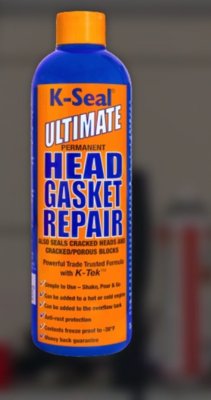There is available for purchase online or at the auto parts store a product for detecting the presence of exhaust in the coolant, aka "head gasket failure" or engine block/cylinder head structural failure. Inexpensive and informative. Add purified or mineral-free water to raise the "cold fill" coolant level to the operating specs. Examine the level at least twice daily, once before the engine is first started and again several hours after the final engine shut off for the day. Inspect the fill level of the tank and also the bottom of cylinder heads and the ground for evidence of leakage. If this evidence is found or the cold fill gradually lowers without visual evidence of leakage, the combustion gas test can be performed and preparations made for service & replacement.
You haven't noticed the presence of displaced fluids on the ground underneath your truck? Have you experienced overheat episodes or fluctuation of operating temperature? Do you have access to diagnostic tools like OBD device which plugs into the socket and displays ECM info?
I've never used blue devil but I can vouch for "K-Seal"
K-Seal held off a faulty head gasket I had for over a year but like Scotty, needed a second application when I changed the coolant. If sealers are used continuously the risk of blockage in various passages becomes a threat but 1 or 2 doses is fine while you save your pennies and weigh the options. Just be certain that you properly diagnose the issue. More often than not, head gasket & structural failures occur due to ongoing overheating from faulty radiator, fan clutch, etc. On the other hand, GM did manufacture a line of faulty cylinder heads with evidence of porosity that is found on specific make/model which you will easily find via Google search. Let us know if your vehicle fits the category of bad batch cyl heads and your findings on the coolant level this week. Don't wait until it gets super hot out before repairing this.
Best time to look visually for leaks is 30-min to 1 hour after the engine is turned off. Slide underneath and look with LED flashlight, hood closed for liquids running down hoses and the engine, especially the back where transmission mates and heater hoses connect to bulkhead.
My main conclusion here, properly diagnose the issue before using any additives or sealers, OK? You don't want to add something like a radiator sealer if there is no evidence of coolant loss, be it internal or external. And then if it's external, proper removal & replacement may be the way to go. And even then, other cooling-related parts could be cause for concern and exacerbating the coolant loss or overheating conditions. Also available for purchase at harbor freight or even rental from big chain auto stores is the radiator pressure tool. It will lose pressure if the cylinder head is porous. It may or may not hold pressure depending on the damage of an actual head gasket. There are principles behind all of these diagnostics but you have to know what you are doing or further damage will result from improper DIY hacks, especially when it comes to the cooling loop. So be careful & thorough, keep the board posted and take the time to ask questions and perform research.
These are the products k-seal?


